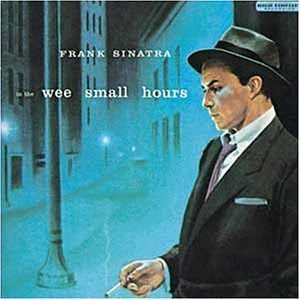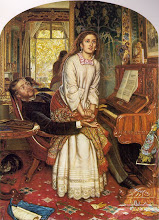
Thank you, Maclin Horton and Tertium Quid, for your excellent suggestions for approaching Music Appreciation (Music 101). I decided to lay aside our textbook yesterday and try to get my students to discuss what music is and what it does. I had brought in some of my own CDs to play for them: an Alan Lomax recording from 1952 of an improvised flamenco song, performed by two impoverished olive workers in Andalusia in a late-night tavern session, the only accompaniment their hands slapping the table in a complex polyrythm (Lomax notes that no one in the town could afford to purchase a guitar); a stirring Yiddish ballad from the turn of the twentieth century by the sweatshop worker/poet Morris Rosenfeld, called “The Exiles’ March”; and the song “In the Wee Small Hours of the Morning,” from the legendary album of the same name by Frank Sinatra. What I was trying to suggest to my class was the notion that music’s job, in essence, is to convey to the listener emotional meaning whose impact is immediate, and that yet almost all music does so by using forms and formulas -- that music is art and not life, and that its imitation of life is based on certain formal structures. Even the passionate fandango improvised in the tavern in southern Spain used certain standard folk poetic verse forms and flamenco singing devices. I was gratified that my students really liked the Spanish number, and that the Yiddish song, which would seem to have a narrow appeal, touched them deeply, especially the black students who make up the majority of the class, some of whom compared it to African-American slave songs. I was disappointed, however, that the great, great Sinatra song seemed at first to offer them no way into its special world. To me the song is perfection itself. The slickness of the production and the lushness of the Nelson Riddle orchestra notwithstanding, the economy of the tune, the tragic irony of the lyrics (with their terse and brilliant use of the second person), and the subtlety of Sinatra’s singing make this number far more heartbreaking – in other words, far more effective – than it would seem to be.
In the wee small hours of the morning,
While the whole wide world is fast asleep,
You lie awake and think about the girl
And never ever think of counting sheep.
When your lonely heart has learned its lesson --
You’d be hers if only she would call --
In the wee small hours of the morning,
That’s the time you miss her most of all.
I suppose that the Sinatra/Riddle aesthetic is far removed from what we listen to today, and young people only encounter it when it’s offered with postmodern self-consciousness, so it's not suprising that the class didn't immediately grasp the art of “In the Wee Small Hours.” But I played it a second time, asking my students to listen actively and try to determine what Sinatra did that made the song work. Finally one young man offered this analysis: Sinatra, he ventured, started each phrase with a crescendo, and ended each phrase with a descrescendo, which suggested initial hope emptying out into resignation. I was impressed and delighted. Those of you who know the song, isn’t that exactly what he does? Those of you who don’t know it, you're missing one of the great works of art of the twentieth century. find it on iTunes – you’ll love it.











7 comments:
I told you you'd be good!
Thanks, T.Q.; I hope my students will "get it" . . . do you know the song? My brother has just told me about a version by the young jazz singer Kurt Elling (see kurtelling.com) that I'm going to try to get hold of too.
Clearly you are going to be a great teacher! (and I was going to say that before I read t.q.'s comment). I love that kind of eclecticism. And I agree about "Wee Small Hours." Never thought about that crescendo/decrescendo movement but it seems true.
I think a lot of people of my generation (boomer) had trouble with Sinatra and similar music because the basic sound was something we associated with TV variety shows, Las Vegas, Hollywood, and show-bizzy hokum in general. To the inattentive ear there's not that much distance from Sinatra to Perry Como to Wayne Newton. It took a little time (and an insistent friend) for me to get past that. I can't explain why college kids would still be having that problem, though.
Here it is on YouTube. Thanks. I wasn't familiar with the song, though I like Sinastra, particularly his version of "Send in the Clowns" and "Fly Me to the Moon."
http://www.youtube.com/watch?v=x3y28-5NPVc
I think that every generation is looking for an authenticity that always seems lacking. The folk revival of the 1950s and 1960s certainly spoke to that -- a kind of backlash againt music like the Sinatra/Riddle "Wee Small Hours" -- as did the punk movement. My students feel like hip-hop music has that authenticity. The Sinatra/Riddle aesthetic is pretty removed from them. But they are starting to appreciate it. We keep talking about aesthetic verisimilitude -- I'll play something and ask them, does this song/artist have it/convey it? I think that's the most important thing in music, although not all music is about that.
Updated YouTube link to Frank Sinatra's In the Wee Small Hours of the Morning
URL, in case the link doesn't work: http://www.youtube.com/watch?v=KqmgldSVgXM
Thank you, Arkanabar. And try this one of Kurt Elling, with a long preamble:
http://www.youtube.com/watch?v=oH0VxA4sA4E
I taught a writing class for music majors the same semester I was teaching this section of Music 101 -- two years ago already, hard to believe -- and I had my writing students write a critical essay in class about which recording of "In the Wee Small Hours" was superior. I got some marvelous essays back. Most of them (90% of my students were jazz players themselves) preferred the Elling version. One of them wrote eloquently about the "heartbeat" motif in the piano as a form of word painting. I have to say I think the Elling version is fantastic beyond words.
Post a Comment